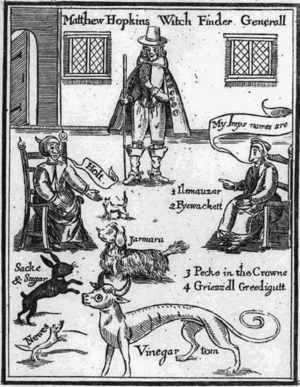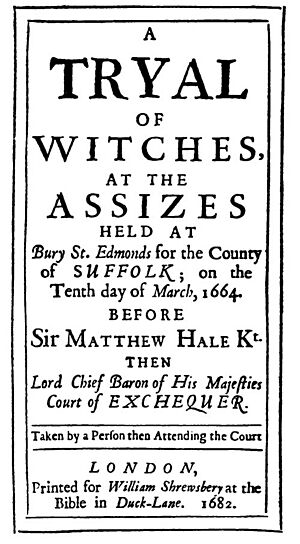Bury St Edmunds witch trials facts for kids
The Bury St Edmunds witch trials were a series of trials that happened in the town of Bury St Edmunds in Suffolk, England. These trials took place many times between 1599 and 1694.
Two trials became very famous: one in 1645 and another in 1662. In 1645, a man called Matthew Hopkins, who called himself the "Witchfinder General," helped with a trial where 18 people were put to death on the same day. The decision made by Sir Matthew Hale, who later became a very important judge, in the 1662 trial had a big effect. It influenced how people continued to accuse and punish people for witchcraft in England and in the early American Colonies.
Contents
Early Witchcraft Accusations
The first known record of a witch trial in Bury St Edmunds was in 1599. Two women, Jone Jordan and Joane Nayler, were tried. We don't know what they were accused of or if they were found guilty. In the same year, another woman named Oliffe Bartham was put to death. She was accused of "sending three toads to destroy the rest (sleep) of Joan Jordan."
The Big Trial of 1645
This trial was started by Matthew Hopkins, the "Witchfinder General." It happened at a special court led by John Godbolt. Even though there was a war going on (the English Civil War), people were worried about how these trials were being handled.
Reports reached the Parliament that people were being forced to confess through torture. So, a special group was formed to make sure the trials were fair. On August 27, 1645, a shocking 18 people were put to death in Bury St Edmunds. Most of them (16 out of 18) were women.
Who Was Accused in 1645?
Some of the people who were put to death included:
- Anne Alderman, Rebecca Morris, and Mary Bacon from Chattisham
- Mary Clowes from Yoxford
- Sarah Spindler, Jane Linstead, Thomas Everard (a barrel maker) and his wife Mary from Halesworth
- Mary Fuller from Combs
- John Lowes, a priest from Brandeston
- Susan Manners, Jane Rivet, and Mary Skipper from Copdock
- Mary Smith from Great Glemham
- Margery Sparham from Mendham
- Katherine Tooly from Westleton
- Anne Leech and Anne Wright, whose hometowns are not known.
It's thought that fewer than 500 people were put to death for witchcraft in all of England between the early 1400s and early 1700s. This one trial in Bury St Edmunds, with its 18 executions, made up a big part of that total.

John Stearne, who worked with Matthew Hopkins, wrote in his book that 120 other people were waiting in jail for trial. After a short break because of the war, the court met again. This second part of the trial led to 68 more people being found guilty. Some reports say "mass executions of sixty or seventy witches" happened.
Both Hopkins and Stearne thought of their hunt for witches like military missions. A newspaper at the time, the Moderate Intelligencer, wrote about the trials in September 1645. It said it was strange that "Devils should choose to be conversant with silly Women that know not their right hands from their left." The paper also said, "Life is precious and there is need of great inquisition before it is taken away." This shows that some people were already questioning these trials.
Another Trial in 1655
Another witch trial in Bury St Edmunds happened in 1655. A mother and daughter named Boram were tried and said to have been put to death.
The Important Trial of 1662
The original report about the 1662 trial, called A Tryal of Witches, was printed anonymously (without a name) twenty years later. This was because people had very different and strong opinions about witchcraft at the time.
The trial started on March 10, 1662. Two older women, Rose Cullender and Amy Duny, who lived in Lowestoft, were accused of witchcraft by their neighbors. They faced 13 accusations of casting spells on several young children, from babies to 18-year-olds. One of the children even died.
Who Accused Them?
A merchant named Samuel Pacy accused the women. He said that both women had come to his house to buy herring, but he had turned them away. Pacy claimed that after this, his two daughters, Elizabeth (age 11) and Deborah (age 9), became sick. Pacy's sister also spoke against the women.
The trial took place in Bury St Edmunds. The judge was Sir Matthew Hale, a very respected judge. He followed the rules of the 1603 Witchcraft Act.
Expert Opinion at the Trial
Thomas Browne, a famous doctor and writer, was at the trial. He was asked for his opinion. He believed that the children were indeed bewitched. He also mentioned similar events that had happened in Denmark. His views might have influenced the jury to find the women guilty. He had written years before that he believed in witches and spirits.
According to the old report, the judge told the jury they only needed to figure out two things: 1. Were the children bewitched? 2. Were the two women guilty of it?
Rose Cullender and Amy Duny were found guilty on March 13, 1662. They were put to death four days later, on March 17, 1662, in Bury St Edmunds.
The 1682 report about the trial mistakenly said it happened in March 1664. But other old documents clearly show it took place in 1662.
A Model for the Salem Witch Trials
This case became very important and was used as an example during the famous Salem Witch Trials in Massachusetts. A clergyman named Cotton Mather wrote a book in 1692 called Wonders of the Invisible World. In it, he specifically pointed to the Bury St Edmunds trial. He wrote that the witchcraft in England was very similar to the witchcraft in Salem. He also said that the judges in New England thought a lot about this English trial.
Cotton Mather's father, Increase Mather, was the head of Harvard College during the Salem trials. He also mentioned the Bury trials as an example in his writings.
Another clergyman, John Hale, wrote about the Salem trials five years later. He noted that the clergy and judges in Salem looked at several books for guidance. One of these was Sir Matthew Hale's description of the Bury St Edmunds trials, A Tryal of Witches.
A Defense for the Accused
In 1718, a minister from Bury St Edmunds named Francis Hutchinson wrote a book. In it, he looked back at these trials and defended the people who had been accused. He also talked about the Salem trials.
Hutchinson used clear thinking to defend the accused. For example, he wrote about a case against Amy Cullender. She had been accused after a cart ran into her house. Hutchinson pointed out that the cart might have had a "jadish horse or a silly driver." He asked if it was more likely that the cart went wrong because of a bad horse or driver, rather than witchcraft. He also questioned why people cut down a post that wasn't even touched, saying they made themselves look foolish just to blame the woman.
The Last Known Trial
The very last recorded witch trial in Bury St Edmunds was in 1694. The judge was Sir John Holt, who did a lot to stop the persecution of witches in England. He made sure that a woman named Mother Munnings was found not guilty. She had been accused of making predictions that caused death. One accusation was about something that happened 17 years earlier, and another came from a man on his way home from a pub. Sir John guided the jury so well that she was set free.
Images for kids
-
Witch Finder General, from a broadside published by Matthew Hopkins before 1650.




